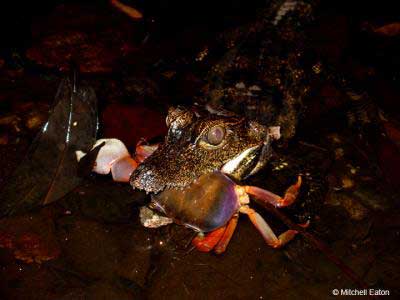Dwarf Crocodiles Split into 3 Species

Looking at the genes of the African dwarf crocodile, researchers found that the group comprises three distinct species rather than one.
This finding ends a long debate about the taxonomy of this group, previously thought to consist of two closely related subspecies, and also defines a new, distinct species from genetic samples.
"In the past, the two morphologically distinct crocodile populations were believed to be different genera, then later different species, and then finally different subspecies," said study leader Mitchell Eaton of the American Museum of Natural History.
"We collected samples in Africa to explore this taxonomic question, and we found a great deal of evolutionary divergence between populations in the Congo Basin and on the west coast of Central Africa," Eaton said. "We also — quite unexpectedly — found a completely new species from far West Africa; there may be even more species that we haven't sampled yet!"
African dwarf crocodiles, genus Osteolaemus, live in the tropical forests of Central and West Africa. Adults typically grow to no more than 5 feet in length and are the smallest living members of the crocodilian family.
The three groups identified in this current research include a species from the Congo Basin (O. osborni), another from Central Africa's Ogooué Basin (O. tetraspis), and the new, yet unnamed species from West Africa.
All of these crocodiles look very similar, and all are widely hunted by local people as a source of food. In fact, these animals provide up to a quarter of the non-fish bush meat consumed in some areas of Central Africa, but over-hunting to supply commercial 'bushmeat' markets may threaten many populations with extinction.
Sign up for the Live Science daily newsletter now
Get the world’s most fascinating discoveries delivered straight to your inbox.
Dwarf crocodiles are listed as vulnerable on the International Union for Conservation of Nature's Red List.
- What's the Difference Between Alligators and Crocodiles?










